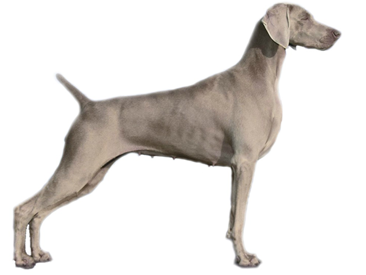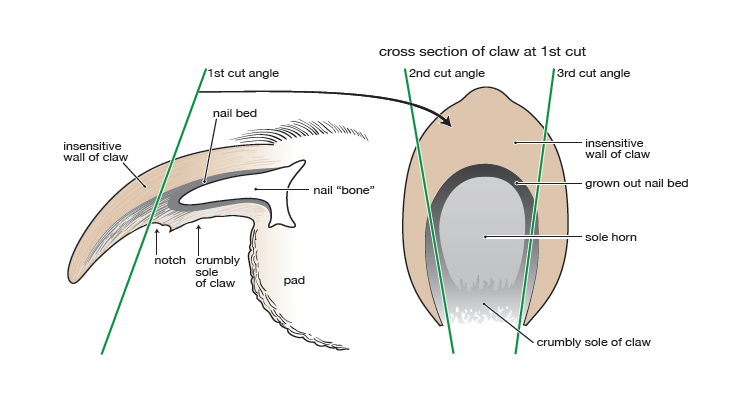Toe Talk —
How Toenail Length has a Direct Effect on Health
by Deb Konkol
(adapted from Weimaraner Club of America Magazine)
Click-Click-Click.•…this is what you hear as the dogs trot through the kitchen. The gentle reminder that you have, yet again, fallen delinquent on nail duty. Why is something that is so important to the health of our dogs, so difficult to keep on schedule for so many of us?
Toenail length is about so much more than the annoying clicking heard through the house or the unsightly appearance of unkempt feet. The length of a dog’s toenails has a direct effect on the dog’s structure, alignment, balance, movement and confidence to perform certain tasks. Excessively long nails can also result in chronic pain and injury.
Think about that for a moment. Would you be more likely to run up and down a flight of stairs with the most confidence, in flat soled shoes or a pair of 6″ high heels?
A few years ago, I had a private training client call me to their home to fix a behavioral issue they were seeing in their dog. They had just moved into a new house and the dog was terrified and refused to walk on the wood floors. When he would muster the courage, he ended up frantically scampering his way across with his legs flailing in all directions, belly flopping and banging his chin, knees and elbows the entire way.
Simply, I trimmed his nails to the proper length. With a little encouragement, positive reinforcement and a bag of treats, we had him trotting happily across the floors from one end of the house to the other. At the root, their dog did not have a behavioral issue, he had a health issue that caused a behavioral issue.
As seen on the attached photo, is an illustration of what happens when a dog’s toenails are allowed to grow excessively tong. When the nail overgrows so much that the tip is resting on the ground, it puts the entire dog out of alignment….first, the phalanx and then the metacarpals /metatarsals and carpus / tarsus joints.
By now, the dog may be “down in the pasterns and hocks” or be leaning back ward with the entire body to alleviate the pressure felt on the digits. This causes the dog to continually hold its self in an unnatural position.
The dog must learn how to dis tribute his weight differently so that he is not constantly off balance. Now, the elbows and knees are bent, scapula and pelvis out of alignment, and the head and neck are usually held low to aid in balance. All of this puts unnecessary stress on the spine and causes tight muscles all throughout the body.
Let us do a simple exercise. Stand up straight with your arms at your sides. Next, flex at your hip and bend your knees. Bend your elbows, shrug your shoulders and extend and lower your head toward the ground or bring your scapulae together. Now, go about your day. Imagine walking around in this position all day long, every day.
It only takes a few minutes to start feeling fatigued, right?? How long until your muscles tighten? How tong until your joints start to ache? How long until each step, starts to cause you significant pain?
Now, holding this position, put on those 6″ high heels and run up and down that flight of stairs….how confident are you? How likely do you think you are to be injured?
As you can see, the length of a dog’s toenails is vitally important. the health of the foot, but also to the overall health of our dogs. Special care should be taken to always keep our senior dogs’ feet in proper condition. As many of them are struggling with arthritis and degenerative joint pain.
Something as simple as keeping our dog’s toenails trimmed to a proper length can help keep them happy and healthy for many years to come.

